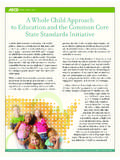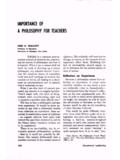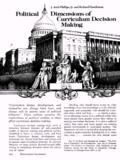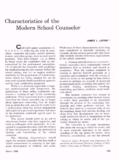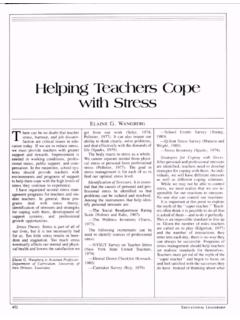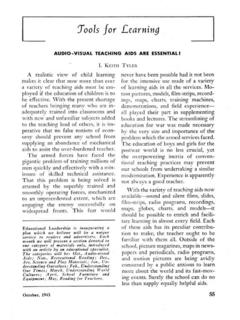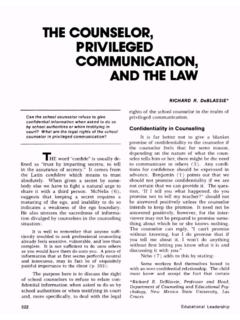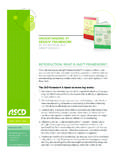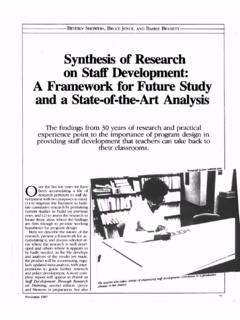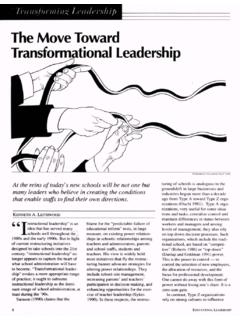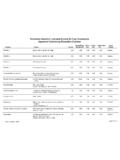Transcription of Bloom's Taxonomy and Critical Thinking Instruction
1 Although its usefulness and influence ineducation is probably unsurpassed, Bloom's Taxonomy has limitations uwhenit comes to developing Critical 's Taxonomy andCritical Thinking InstructionRICHARD W. PAI Lt would be difficult to hfind a m reinfluential vwork in education to-day than TMe Taxonoml of Educa-tional Objecties (Blo(xm and ). Developed bh a committee ofcollege and universitr examiners from1949 to 1954 and published as twohandh:x)ks--Cogrnitive Domain andAffectWe Domain--its bhjectives weremanifold. Handbook I. Cognit:ze )Domain. for instance. lists four encom-passing objectix es:I To provide for classification ofthe goals otf our educational be of general help to all teachers,administrators.
2 Professional specialists. and research workers who dealwith curricular and evaluation problems to help them discuss theseproblems with greater precision '2 To 'be a source of constructivehelp in building a curriculum3 To help one gain a perspectiveon the emphasis given to certain he-haviors '4- To 'specif- objectives so that itbecomes easier to plan learning expe-riences and prepare evaluation de-vices .( pp 1 2)The authors note as well that thecategories of the Taxonom (F Iigure 1 )can be used 'as a framework for viewing the educational process and ana-hlzing its workings' and even for ana-lvzing teaches' success in classroomteaching' (p 3)A generation of teachers have nowcome of age not only familiar with and"acceptant' of the general categoriesof the Taxonomy .
3 But also persuadedthat the Taxonom! s identified higher-order skills of analhsis, synthesis. andevaluation are essential to education atbte in the tfdONw_ n I ,m 1bLmairrr-n -m hWF;*h particul [l ilea%. ruhptl ;,also b- t,- h rntC I,applid rll~~Organrmzaonal f'rlr pb.,lion ot d ~nle C(ommunmil,-,r !(tln It d blan, or PP rl rpo' ,rivation of Ia rf :, AbIa(t (0J'Itr -f[ ludronis In Trrn2urfrhrtc In ler3 Fror, ;, ..all lc-vels Fr thescthinking is essentialorder skills are essenrto think criticalkl inlearn how% to ask andof anal -sis. sx To lecathis -ieuans,-er qu,c and evanal Fwomi(nal Crit'rlbjet tivcriticalhigher-irn how'x is toesti onsluation/' /197 t p 20t1( )rt-li, I di.)))))]]
4 I''o li) pl tc a(hcers il)rp)ritc criiticalthinking in tdie cl;aissr)om ix to helpRi/trcld W ' I I)i,-tol,, (.ct(lrl /1}oC t)Cit/cal l/lt Lt'ki d (irl d lhtzo l ('t'tlt/lwe. 5` 1 Orto 'ittl' I tIl/(')%, Roittit / Park, (,ath(fo711I36Ei I , :% II,)\. \1 1,1,;\i )I H'I III -Vtthem ask qLuestl Ins that call for analvsis, s\nthlesis. and evaluatio n In thisview, then. learning to teach criticalthinking is quite straightf)ornard Thethinking O(f the teacher does not needto) be signilicantl- altered. and no fun-damental shifts in educational philoso-ph! are required The Txonom\ andthe abilit! to generate a full variety ofquestion itpes are all that an intelli-gent teacher reall needs to leach criti-cal Thinking skillsThis view is signiicantly misleadingAccording to mo st ad i)c ates (tf criticalthinking, there is no neat set of recipesfor fostering Critical Thinking in stu-dents The single most useful thing ateacher Canl do is to( take at le;ast onewsell-designed college course in criti-cal Thinking , in xxhich the teictulw'-soulw thinkinlg skills are anall vzed andnurturel in a varlet\ it x va ;s- In oltherswords.
5 Teachers should have a solidIo(undatilon in Critical Thinking skills ifthel are expected it) elach themWXhat I llo IisS Is a SUicCin t t all sxsisand critiqIe oit l II)onm s Taxonoms,from the perspec ti e oi the values andepislem)loOgitCll Irl- llepplositilns ofthe Critical Thinking movement I hopeit will cintrihulie itl a deeper under-standinig it the in;lura ;Intd deilands ofcritical thinkinlg insrttctl )nA One-Way HierarchyThough n it designed t() firtiher criti-tlat Thinking instructio)n i;i such. C(og-tire Domal i colntaiins a sealitSl of in-fiormatioln oti' Lse in such inlsMt-uctinrReading it in its entirelr is nlst re-wsarding, particularly the sections onanalysis, s ntlhests.
6 Alnd sections disclise thalt mllst oftile cognitive processes characterizedas essential it) higher-order questionsin fact presuppose use of the basicconcepts of Critical Thinking : assump-tion. fact. concept. value. evidence. relevant. irrele-vant. consistent. inconsistent. implica-tion. fallacy. argument. of s-ie'. hias. prejudice. author-itx. alnd so forth This is,clear, for example. in the explanalionof analysis:Skill in analysii nia\ be fI)und Ls anobjectise of an \ held ot sluds it is trequenlly expressed ias one of their impor-lanl obhjecties h- lteachers of science. so-cial studies. philosoph '.
7 And the arts lfhewish. for eallmpe. i, t develop in studentsthe ahilin- to disinguish tact fronm h\pot he-sis in a co llmnllication. to identify conclu-sitons and supporting statements. to) distin-guish relevan frOnll extraneous matlerial. tonote ho i one idea relates to another. tosee Isfhat unstated assmuniptiols are in-volved in xhal ih iaid. to distinguish domi-nanl from subordinate ideas or themes inpoemtr or music. toi find evidentce of theauthoir s techniques alnd purposes I CogYlitile /)Omatlti. p 1-4 )In other words. if the abhilit toanalyze t ipc;illl requires students to)do such thinlg as distinguish factsfronm h xpotheses.
8 Conclusions ft-om e\ -idence, rdesvatl fronm irrelev ant material. to note hos- o)ne coincept relatesto another. to probe and detect unstat-ed assumptions. then it seems essen-tial that stuldents he)come nOt onlyfamiliar sith these e iords (bh teachersintroducing thenm frequentl- intoclassroom discussio n) hut Ialso com-fortahle x- ith using them ;is the! thinktheir xxa! through analitic problemsThis need hecomes more evident if sxerecognize that h\ analysis, evaluation, the authors of the Tax-onom!- have in mind only explicit (notsubconscious) uses of them Thevrightly emphasize what has become avirtual platitude in cognitive psvcholo-gy-that students (and experts) whodo the best ana;ll-ses syntheses, andevaluations tend to do them mindfull\w-ith a clear sense of their componentelements.
9 So, if the concepts of criticalthinking are presupix)sed in mindfulanal-sis. synthesis. and evaluation, wecan best heightlen that mindfulness bvraising those component concepts to aconscious lev elSimilarl-. value ,ertrtalli'is impliedinl Affecttv Domainu although man\- ofthe examples of higher-order valuingare illustrations of values intrinsic toeducation conceived on a criticalthinking paradigm, ones in which astudentDeliberateI exanmines a varien of v-ilc-points on controviersal issues n-ith a -le\-to forming OpilllOns a)umt thenmI Developsi faith in the plower ot reaxsonill mnethodls of experimenital discussion.
10 'eigfhs altemnative social policies andpractices against the standards of the pub-lic sselfare ratier than the advantage ofSpeciallzed and narrow interest groupsIAchievesl readiness to revise judgmentsatnd to chatnge Iehaslor in ttie light ofevidenceJudges pr hlems and isues in terms ofsituations. issues. purl)ses. and conse-quences in-olved rather than in terms oftixed dognmatic precepts or emotionall\n-ishful thirkingDevelops a colnistlnl pfilosoophy of lifetpp 18-t8 )Al)ong -ith the usefulness ofBlooxl s C(ogniti\-e and Affective Tax-onomies. it is imrportant to bear inmind their limitations for criticalthinking curriculum constructicon ToMv\ 19)S -some extent the Taxonomies repre-sent an attempt to achieve the impossi-ble: a perfectly neutral classification ofcognitive and affective processes thatmakes no educational value judgmentsand favors no educational philosophyover any other-one that could beused bv anv culture, nation, or systemwhatsoever, independent of its specif-ic values or world view.
